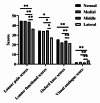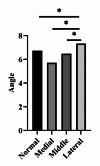Intraoperatively identified patellofemoral osteoarthritis: no significant impact on short-term outcomes of medial unicompartmental knee arthroplasty
- PMID: 39773478
- PMCID: PMC11708006
- DOI: 10.1186/s12891-024-08270-8
Intraoperatively identified patellofemoral osteoarthritis: no significant impact on short-term outcomes of medial unicompartmental knee arthroplasty
Abstract
Background and objective: The efficacy of medial unicompartmental knee arthroplasty (UKA) in patients with intraoperatively identified patellofemoral osteoarthritis (PFOA) has been a subject of debate. This retrospective study aimed to investigate the early outcomes of UKA in patients with varying intraoperative PFOA conditions and to explore the relationship between the location of PFOA and the position of the prosthesis post-UKA. Our aim was to determine whether the presence of PFOA affects the short-term success of medial UKA.
Methods: This single-center, retrospective study included patients who underwent UKA by a same surgical team from March 2021 to November 2022. Patients were categorized into normal, medial, middle, and lateral groups based on the intraoperative PFOA findings. A total of 103 patients were analyzed, with data collected on demographics, intraoperative details, and pre- and postoperative laboratory and imaging data. Patellofemoral joint cartilage damage was assessed using the Outerbridge classification. Postoperative patellofemoral joint function was evaluated using the Lonner score, Oxford Knee Score (OKS), and visual analog scale (VAS) for pain.
Results: Significant improvements were observed in postoperative Lonner pain scores, Lonner functional scores, OKS, and VAS compared to preoperative values for all groups (P < 0.05). Medial and middle PFOA identified intraoperatively did not affect the short-term efficacy of medial UKA. Although lateral PFOA had some impact on UKA efficacy, patients still experienced significant postoperative pain relief and functional improvement. Differences in the tibial component posterior slope angle (TCPSA) were noted among the groups, particularly between the medial and lateral groups (P < 0.05).
Conclusion: Intraoperatively identified medial and middle PFOA do not influence the short-term efficacy of medial UKA. Lateral PFOA has some impact on UKA outcomes, yet patients demonstrate significant improvements in postoperative pain and function. Intraoperative PFOA should not be considered an absolute contraindication for medial UKA. The study's follow-up duration was relatively short, necessitating further research on the mid- to long-term effectiveness of UKA in patients with combined PFOA.
Keywords: Efficacy; Patellofemoral osteoarthritis; Prosthesis; Unicomparment knee arthroplasty.
© 2025. The Author(s).
Conflict of interest statement
Declarations. Ethics approval and consent to participate: The study was conducted in accordance with the Declaration of Helsinki. Ethical approval was obtained from the Ethics Committee of Ningde Municipal Hospital Affiliated to Ningde Normal University (Number: NSYKYLL-2023-069). Informed consent was obtained from all subjects involved in the study. Consent for publication: Participants in the study consent for publication. Competing interests: The authors declare no competing interests.
Figures
Similar articles
-
[Influence of patellofemoral joint degeneration on outcome of medial unicompartmental knee arthroplasty].Zhonghua Wai Ke Za Zhi. 2017 Jun 1;55(6):416-422. doi: 10.3760/cma.j.issn.0529-5815.2017.06.004. Zhonghua Wai Ke Za Zhi. 2017. PMID: 28592073 Chinese.
-
Does Medial Patellofemoral Osteoarthritis Influence Outcome Scores and Risk of Revision After Fixed-bearing Unicompartmental Knee Arthroplasty?Clin Orthop Relat Res. 2019 Sep;477(9):2041-2047. doi: 10.1097/CORR.0000000000000738. Clin Orthop Relat Res. 2019. PMID: 31140980 Free PMC article.
-
A decreased tibial tuberosity-trochlear groove distance is associated with lateral patellofemoral joint degeneration after implantation of medial fixed-bearing unicompartmental knee arthroplasty - a minimum five year follow-up.Int Orthop. 2023 Sep;47(9):2225-2233. doi: 10.1007/s00264-023-05812-y. Epub 2023 Apr 26. Int Orthop. 2023. PMID: 37100957
-
The impact of patellofemoral joint diseases on functional outcomes and prosthesis survival in patients undergoing unicompartmental knee arthroplasty: a systematic review and meta-analysis.J Orthop Surg Res. 2024 Dec 19;19(1):840. doi: 10.1186/s13018-024-05273-y. J Orthop Surg Res. 2024. PMID: 39696549 Free PMC article.
-
The impact of anterior cruciate ligament deficiency severity on the outcomes of fixed-bearing unicompartmental knee arthroplasty: a retrospective study.J Orthop Surg Res. 2025 Mar 6;20(1):244. doi: 10.1186/s13018-025-05635-0. J Orthop Surg Res. 2025. PMID: 40050997 Free PMC article. Review.
References
-
- Tan MWP, et al. Long-term functional outcomes and quality of life at Minimum 10-Year Follow-Up after fixed-bearing unicompartmental knee arthroplasty and total knee arthroplasty for isolated medial compartment osteoarthritis. J Arthroplast. 2021;36:1269–76. - PubMed
-
- Pandit H, et al. Unnecessary contraindications for mobile-bearing unicompartmental knee replacement. J Bone Joint Surg Br Vol. 2011;93–B:622–8. - PubMed
-
- Liddle AD, Pandit H, Judge A, Murray DW. Effect of Surgical caseload on Revision Rate following total and Unicompartmental Knee Replacement. J Bone Joint Surg. 2016;98:1–8. - PubMed
MeSH terms
LinkOut - more resources
Full Text Sources
Medical



